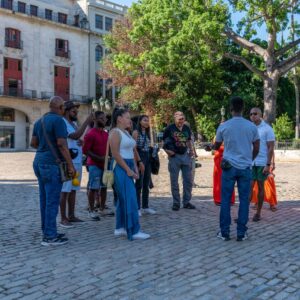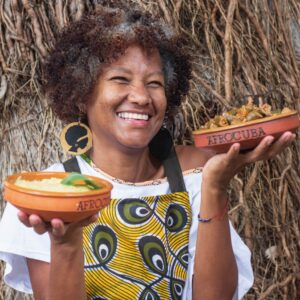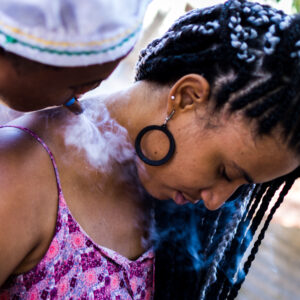Oyá is the Orisha of storms, winds, the cemetery gates, and transformation. She is fierce, commanding, and deeply connected to movement and change. Her dance is full of turns, dramatic gestures, and sweeping motions, reflecting her dominion over hurricanes and the winds of change.
You may notice dancers performing sudden spins and fast directional changes, symbolizing the swirling chaos of a storm. The shouts or cries that often accompany Oyá’s dance are not random—they are calls to the spirits, honoring her role as guardian of the ancestors. The volteretas (acrobatic rolls or falls) reflect her warrior side and her connection to the unpredictability of life and death.
When Oyá is danced, she takes over the space. You don’t just see her—you feel her.
BOOK NOW – AFRO CUBAN ROOTS EXPERIENCE
Elegguá is the childlike Orisha of beginnings, crossroads, and destiny. He is playful, clever, and deeply respected, for no ritual can begin without his blessing. His dance captures this duality of innocence and wisdom with a combination of playful hops, sudden freezes, and nimble footwork.
You’ll often see Elegguá dancers moving quickly in unpredictable patterns—disappearing and reappearing, mimicking his ability to show up where you least expect him. The high-pitched cries or sharp whistles represent his mischievous nature and the surprises he brings to the paths of life.
Despite his humor, Elegguá holds immense spiritual weight. His dance is often the first to be performed, marking the opening of the spiritual portal.
Yemayá is the Orisha of the sea and motherhood. Her dance flows like water, with expansive, undulating arm movements that mimic ocean waves. Her dancers often wear wide, layered skirts, which they use as extensions of their bodies—lifting and swaying them in rhythmic, circular motions.
The slow build and emotional intensity of Yemayá’s dance reflect the sea’s dual nature—nurturing yet powerful, calm yet fierce. Her dance may include low bends and rising motions, symbolizing the pull of the tide and the womb of life. Her cries are deep and resonant, often evoking a sense of sacred nurturing or spiritual mourning.
Watching Yemayá dance is like being embraced and tested by the ocean all at once.
BOOK NOW – THE RHYTHM OF THE ORISHAS EXPERIENCE
Why They Dance That Way: Movement as Sacred Language
In the world of Afro-Cuban spirituality, movement is memory. The gestures of the Orishas are not choreographed—they are inherited. These dances carry centuries of encoded knowledge, allowing each Orisha to speak through the body of the dancer. The volteretas, cries, skirt-work, and foot stomps are all part of a language that calls forth the divine, transforms the space, and invites the audience to witness the sacred.
These dances are not just performances—they are spiritual experiences. They happen in ceremonies, in celebrations, and even in immersive cultural experiences like our Ritmo de los Orishas performance at the Centro de las Raíces.
If you’re ready to witness the magic in motion, join us for a transformative journey through Afro-Cuban spirituality with our Ritmo de los Orishas experience. You’ll meet the Orishas through music, dance, and story—and maybe even feel them speak through the rhythm.👉 Download our free travel guide to prepare for your journey to Cuba and dive deeper into its living Afro traditions.



